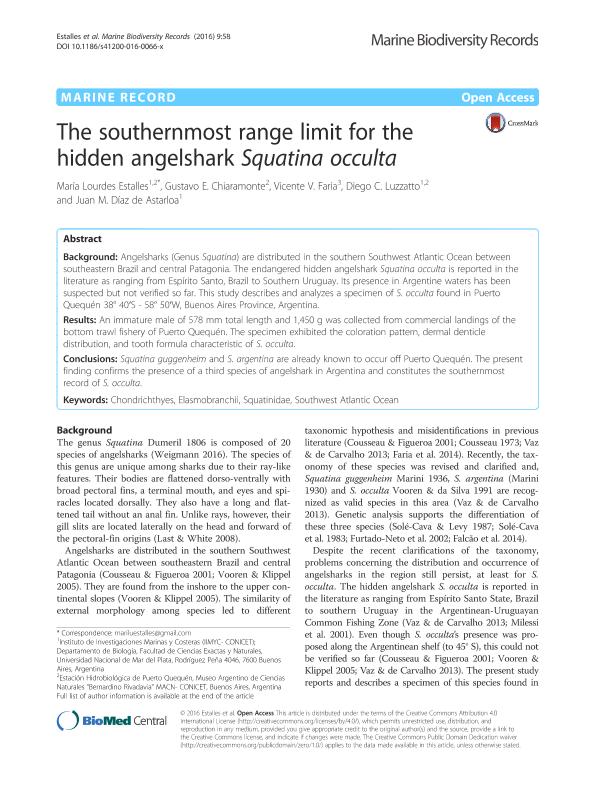Artículo
The southernmost range limit for the hidden angelshark Squatina occulta
Estalles, María Lourdes ; Chiaramonte, Gustavo Enrique
; Chiaramonte, Gustavo Enrique ; Faria, Vicente V.; Luzzatto, Diego
; Faria, Vicente V.; Luzzatto, Diego ; Díaz de Astarloa, Juan Martín
; Díaz de Astarloa, Juan Martín
 ; Chiaramonte, Gustavo Enrique
; Chiaramonte, Gustavo Enrique ; Faria, Vicente V.; Luzzatto, Diego
; Faria, Vicente V.; Luzzatto, Diego ; Díaz de Astarloa, Juan Martín
; Díaz de Astarloa, Juan Martín
Fecha de publicación:
08/2016
Editorial:
BioMed Central
Revista:
Marine Biodiversity Records
ISSN:
1755-2672
Idioma:
Inglés
Tipo de recurso:
Artículo publicado
Clasificación temática:
Resumen
Background: Angelsharks (Genus Squatina) are distributed in the southern Southwest Atlantic Ocean between southeastern Brazil and central Patagonia. The endangered hidden angelshark Squatina occulta is reported in the literature as ranging from Espírito Santo, Brazil to Southern Uruguay. Its presence in Argentine waters has been suspected but not verified so far. This study describes and analyzes a specimen of S. occulta found in Puerto Quequén 38° 40′S - 58° 50′W, Buenos Aires Province, Argentina. Results: An immature male of 578 mm total length and 1,450 g was collected from commercial landings of the bottom trawl fishery of Puerto Quequén. The specimen exhibited the coloration pattern, dermal denticle distribution, and tooth formula characteristic of S. occulta. Conclusions: Squatina guggenheim and S. argentina are already known to occur off Puerto Quequén. The present finding confirms the presence of a third species of angelshark in Argentina and constitutes the southernmost record of S. occulta.
Palabras clave:
Chondrichthyes
,
Elasmobranchii
,
Squatinidae
,
Southwest Atlantic Ocean
Archivos asociados
Licencia
Identificadores
Colecciones
Articulos(IIMYC)
Articulos de INSTITUTO DE INVESTIGACIONES MARINAS Y COSTERAS
Articulos de INSTITUTO DE INVESTIGACIONES MARINAS Y COSTERAS
Articulos(MACNBR)
Articulos de MUSEO ARG.DE CS.NAT "BERNARDINO RIVADAVIA"
Articulos de MUSEO ARG.DE CS.NAT "BERNARDINO RIVADAVIA"
Citación
Estalles, María Lourdes; Chiaramonte, Gustavo Enrique; Faria, Vicente V.; Luzzatto, Diego; Díaz de Astarloa, Juan Martín; The southernmost range limit for the hidden angelshark Squatina occulta; BioMed Central; Marine Biodiversity Records; 9; 58; 8-2016; 1-5
Compartir
Altmétricas



